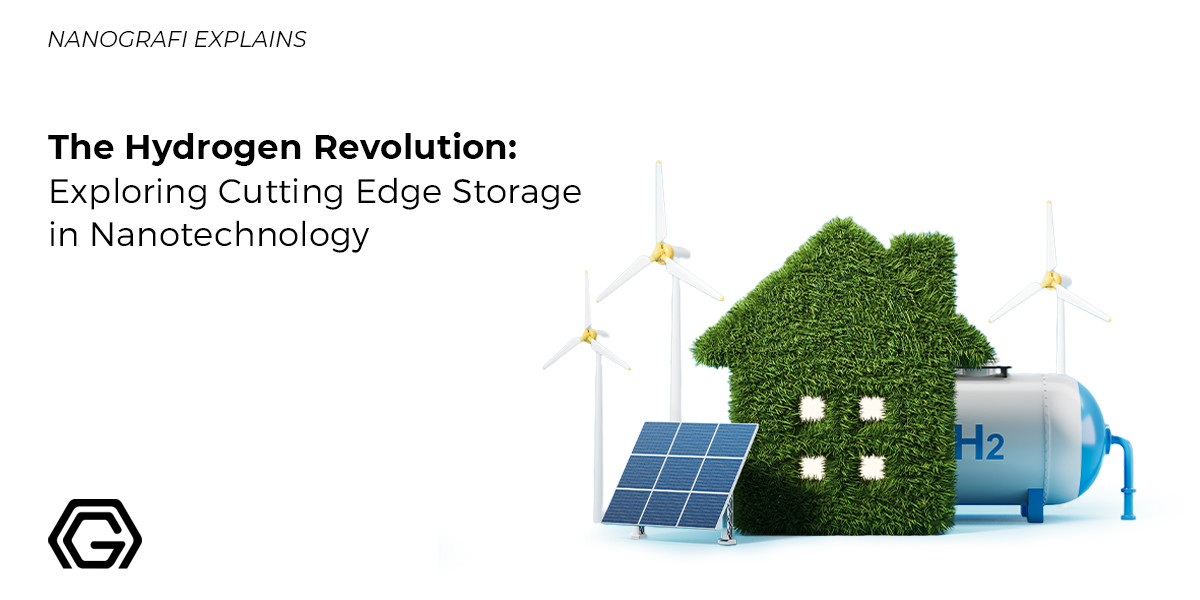The Hydrogen Revolution: Exploring Cutting Edge Storage in Nanotechnology - Nanografi
Hydrogen storage refers to the process of storing hydrogen gas in a compact and efficient manner for later use as an energy carrier. As an energy carrier, hydrogen has gained significant attention due to its potential to address various energy challenges, particularly in the context of renewable energy integration and decarbonization efforts.
First and foremost, it is a versatile and clean-burning fuel. When hydrogen is combusted or used in fuel cells, it produces only water vapor as a byproduct, resulting in zero greenhouse gas emissions. This makes hydrogen a promising alternative to fossil fuels, which contribute to climate change. Moreover, hydrogen has a high energy density, meaning it contains a large amount of energy per unit mass or volume. Hydrogen is a low-density gas at standard temperature and pressure, making it challenging to store and transport efficiently. We, Nanografi, closely follow your works and projects that contribute to sustainability and we bring our products together with you for this purpose.
Introduction
The term "hydrogen storage" has sparked significant interest in sustainable and clean energy solutions. With its high energy content and potential for zero-emission applications, hydrogen has emerged as a promising alternative for a greener future.
From fueling transportation to supporting grid stability and enabling renewable energy integration, hydrogen's versatility makes it an attractive candidate for addressing the global energy puzzle. However, one of the most significant hurdles to widespread hydrogen adoption lies in its efficient storage and transportation. As a lightweight and highly reactive gas, storing hydrogen in a compact and safe manner has been a longstanding challenge.
Types of Hydrogen Storage Methods
There are several methods for hydrogen storage, including compression, liquefaction, and solid-state storage.
- Compression: Hydrogen gas can be compressed and stored in high-pressure tanks. This approach allows for a substantial amount of hydrogen to be stored in a relatively small volume. However, compression requires energy and can be energy-intensive.
- Liquefaction: Hydrogen can be cooled and converted into a liquid state, significantly reducing its volume. Liquid hydrogen has a higher energy density compared to compressed gas. However, liquefaction also requires a substantial amount of energy and cryogenic infrastructure for storage and handling.
- Solid-state storage: This method involves chemically or physically trapping hydrogen within a solid material, such as metal hydrides, chemical hydrides, or carbon nanomaterials. Solid-state storage offers the potential for high-density hydrogen storage and controlled release, but it still faces challenges related to reversibility, kinetics, and cost.
Efficient and cost-effective hydrogen storage technologies are crucial for the widespread adoption of hydrogen as an energy carrier. Advances in storage methods are being researched and developed to improve the overall efficiency, safety, and practicality of hydrogen storage, making it a viable solution for a range of applications, including transportation, stationary power, and energy grid balancing.
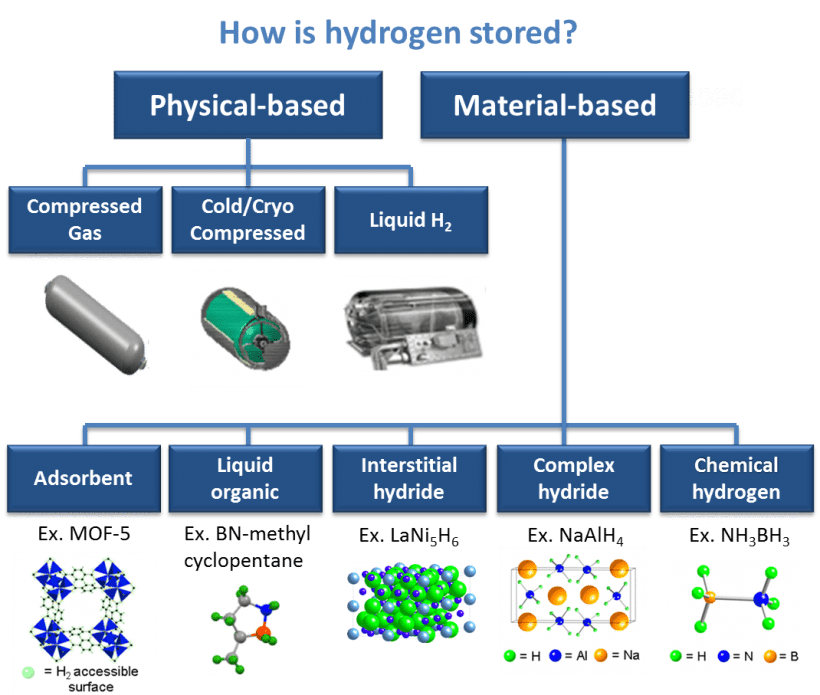
Figure 1. How hydrogen storage works.
Compressed Hydrogen Storage
Compressed hydrogen storage is one of the methods used to store hydrogen gas for various applications. It involves compressing hydrogen gas to high pressures and storing it in specially designed tanks or cylinders.
Compression process: Hydrogen gas is compressed using a compressor to increase its pressure. The compression is typically done in multiple stages to achieve higher pressures. The most common compression levels for hydrogen storage range from 350 to 700 bar (5,000 to 10,000 pounds per square inch).
Types of High-pressure Tanks
Storage tanks: Compressed hydrogen is stored in tanks made of high-strength materials capable of withstanding the high pressures involved. The tanks are designed to ensure safety, durability, and integrity during storage and transportation. Common tank materials include carbon fiber composites, metal alloys, or a combination of both.
Energy density: Compressed hydrogen storage offers a relatively high energy density compared to other storage methods. It allows for a significant amount of hydrogen to be stored in a relatively small volume, enabling applications that require compact storage, such as full cell vehicles.To gain further insight into this matter and to comprehend how fuel cells are being transformed by breakthroughs in nanotechnology, you can read our recent blog.
Refueling considerations: Compressed hydrogen can be dispensed from storage tanks into fuel cell vehicles or other hydrogen-powered devices. However, the refueling process requires specialized infrastructure, including high-pressure dispensing equipment and safety measures to handle the compressed gas.
Challenges and Limitations
Compressed hydrogen storage is widely used in applications such as fuel cell vehicles, where it provides a practical solution for storing and supplying hydrogen gas to power the vehicles. However, it also has some limitations, such as the energy required for compression, the need for high-pressure storage infrastructure, and the potential for energy loss during compression and decompression processes.
Liquid Hydrogen Storage
Liquid hydrogen storage is a method of storing hydrogen in its liquid state, achieved by cooling hydrogen gas to extremely low temperatures. Here are the key aspects of liquid hydrogen storage:
Properties of Liquid Hydrogen
Liquefaction process: Hydrogen gas is cooled to temperatures below its boiling point (-252.87°C or -423.17°F) using cryogenic refrigeration systems. This process converts hydrogen gas into a liquid state, which results in a significant reduction in volume. The liquefaction process requires specialized equipment and facilities capable of handling cryogenic temperatures.
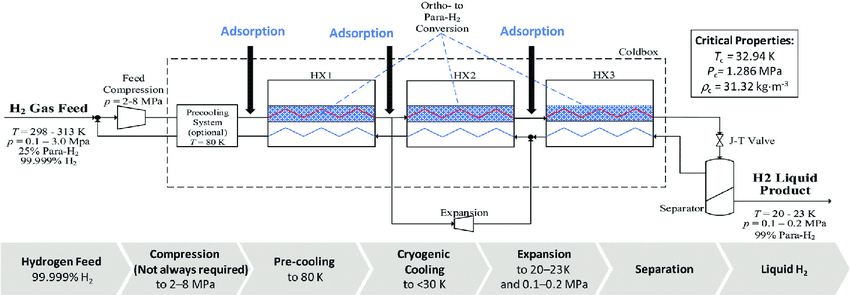
Figure 2. Hydrogen gas liquefaction process.
Storage containers: Liquid hydrogen is stored in insulated tanks specifically designed to maintain the extremely low temperatures and prevent heat transfer from the surroundings. These tanks are typically double-walled with a vacuum between the walls to minimize heat ingress.
Energy density: Liquid hydrogen storage offers higher energy density compared to compressed hydrogen gas. By transitioning hydrogen from a gaseous to a liquid state, its volume is reduced by a factor of about 1:800.
Handling considerations: Handling liquid hydrogen requires strict adherence to safety protocols due to its extreme cold temperature. Specialized safety measures, including proper protective equipment, insulation, and venting systems, are essential to prevent injuries and ensure safe storage and transportation.
Boil-off and loss: Even with proper insulation, liquid hydrogen will experience some boil-off due to heat ingress. This boil-off must be managed to prevent excessive loss of stored hydrogen.
Overview of Metal Hydride Hydrogen
Metal hydrides are compounds formed by the combination of metal elements with hydrogen. These compounds exhibit unique properties, particularly their ability to reversibly store and release hydrogen. Metal hydrides have gained significant attention as potential hydrogen storage materials and find applications in various fields. Here is an overview of metal hydrides:
Hydrogen storage: Metal hydrides have the ability to store hydrogen through a process called hydrogen absorption. When hydrogen gas comes into contact with a metal hydride, the hydrogen atoms bond with the metal atoms to form a solid compound. This allows for the storage of hydrogen within the crystal structure of the metal hydride.
Reversibility: One of the significant advantages of metal hydrides is their reversibility. They can release the stored hydrogen under specific conditions, such as heating or reducing the pressure.
Types of metal hydrides
Metal hydrides can be categorized into two main groups:
Interstitial hydrides: These metal hydrides form when hydrogen atoms occupy the interstitial spaces between metal atoms in the crystal lattice. Examples of interstitial hydrides include titanium hydride (TiH2) and vanadium hydride (VHx).
Complex hydrides: These metal hydrides form when hydrogen reacts with metal compounds or alloys to form more complex structures. Examples of complex hydrides include lithium aluminum hydride (LiAlH4) and sodium borohydride (NaBH4).
a. Tih2: Structure and Properties
TiH2, also known as titanium hydride, is an interstitial metal hydride compound formed by the combination of titanium (Ti) and hydrogen (H). Here is an overview of the structure and properties of TiH2:
Structure:
Crystal structure: TiH2 crystallizes in the hexagonal crystal system and adopts the space group P6/mmm. It forms a layered structure with hexagonal close-packed (hcp) titanium layers and interstitial hydrogen atoms occupying the octahedral sites between the titanium layers.
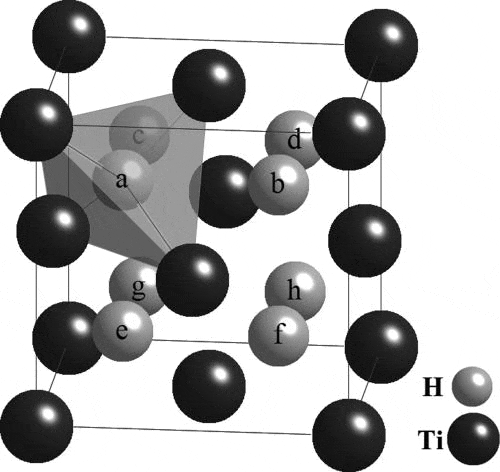
Figure 3. Tih2 crystal structure.
Titanium layers: The titanium atoms in TiH2 form hcp layers, where each titanium atom is surrounded by six neighboring titanium atoms. These layers are held together by strong metallic bonds.
Interstitial hydrogen: The hydrogen atoms occupy the octahedral sites between the titanium layers, forming TiH6 octahedra.
Properties:
Hydrogen storage capacity: TiH2 is known for its high hydrogen storage capacity. It can absorb hydrogen gas and store it within its crystal structure. The exact storage capacity depends on various factors, including temperature, pressure, and the TiH2 composition.
Stability: TiH2 exhibits good stability under normal conditions. It is stable at room temperature and can retain its hydrogen storage properties over extended periods.
Reactivity: TiH2 is reactive with water and strong acids, releasing hydrogen gas. This reactivity can be advantageous for hydrogen generation or as a hydrogen source in specific applications.
Thermal stability: TiH2 has a relatively high thermal stability, allowing it to withstand elevated temperatures without significant decomposition. However, excessive heating can cause TiH2 to release hydrogen and undergo phase transformations.
Density: TiH2 has a relatively high density, with a value of approximately 3.8 g/cm³. This density contributes to its ability to store a significant amount of hydrogen within a small volume.
It's worth noting that the specific properties of TiH2 can vary depending on factors such as the TiH2 composition, processing methods, and any doping or modifications introduced during its synthesis. Researchers continue to explore ways to optimize the properties of TiH2 and other metal hydrides to enhance their hydrogen storage capabilities and address any limitations they may have for practical applications.
b. ZrH2: Structure and Properties
ZrH2, also known as zirconium hydride, is an interstitial metal hydride compound formed by the combination of zirconium (Zr) and hydrogen (H). Here is an overview of the structure and properties of ZrH2.
Structure:
Crystal structure: ZrH2 crystallizes in the hexagonal crystal system and adopts the space group P6/mmm, similar to TiH2.
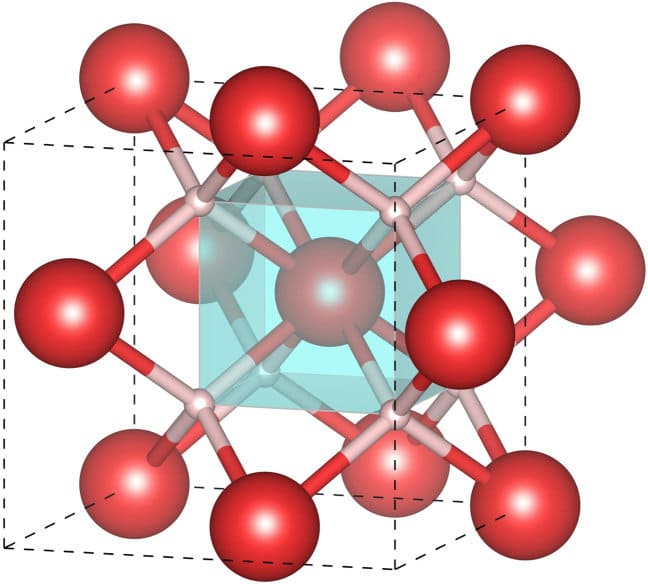
Figure 4. ZrH2 crystal structure.
Zirconium layers: The zirconium atoms in ZrH2 form hcp layers, similar to TiH2. Each zirconium atom is surrounded by six neighboring zirconium atoms, creating strong metallic bonds.
Interstitial hydrogen: The hydrogen atoms occupy the octahedral sites between the zirconium layers, forming ZrH6 octahedra. Each hydrogen atom is bonded to three neighboring zirconium atoms. The presence of interstitial hydrogen gives ZrH2 its hydrogen storage capacity.
Properties:
Hydrogen storage capacity: ZrH2 exhibits a notable hydrogen storage capacity. It can absorb hydrogen gas and store it within its crystal structure. The storage capacity depends on various factors, such as temperature, pressure, and the composition of ZrH2.
Stability: ZrH2 is generally stable under normal conditions. It retains its hydrogen storage properties over extended periods at room temperature. However, like other metal hydrides, ZrH2 can undergo structural changes and phase transformations under certain conditions, affecting its hydrogen storage performance.
Reactivity: ZrH2 can react with water or strong acids, releasing hydrogen gas. This reactivity can be advantageous for hydrogen generation or as a hydrogen source in specific applications.
Thermal stability: ZrH2 has good thermal stability, allowing it to withstand elevated temperatures without significant decomposition. However, excessive heating can cause ZrH2 to release hydrogen and undergo phase changes.
Mechanical properties: ZrH2 exhibits good mechanical properties, including high strength and hardness. These properties make it useful in applications where both hydrogen storage and mechanical strength are required.
It's important to note that the specific properties of ZrH2 can vary depending on factors such as the ZrH2 composition, processing methods, and any doping or modifications introduced during its synthesis.
Advantages and challenges:
Metal hydrides offer several advantages as hydrogen storage materials. They can achieve high hydrogen storage capacities, have good stability, and are generally safe to handle. However, challenges remain, including the need for optimized reaction kinetics for efficient hydrogen uptake and release, the development of lightweight and low-cost materials, and addressing thermodynamic limitations to enhance storage capacities.
Applications:
Metal hydrides have applications beyond hydrogen storage. They are used in hydrogen purification and separation processes, hydrogen fuel cells, thermal energy storage, heat pumps, and hydrogen sensors. Metal hydrides also have potential in other fields, such as hydrogenation reactions in chemical processes and as catalysts in various industrial applications. Research and development efforts are focused on exploring new metal hydrides, optimizing their properties, and improving their performance for hydrogen storage and other applications.
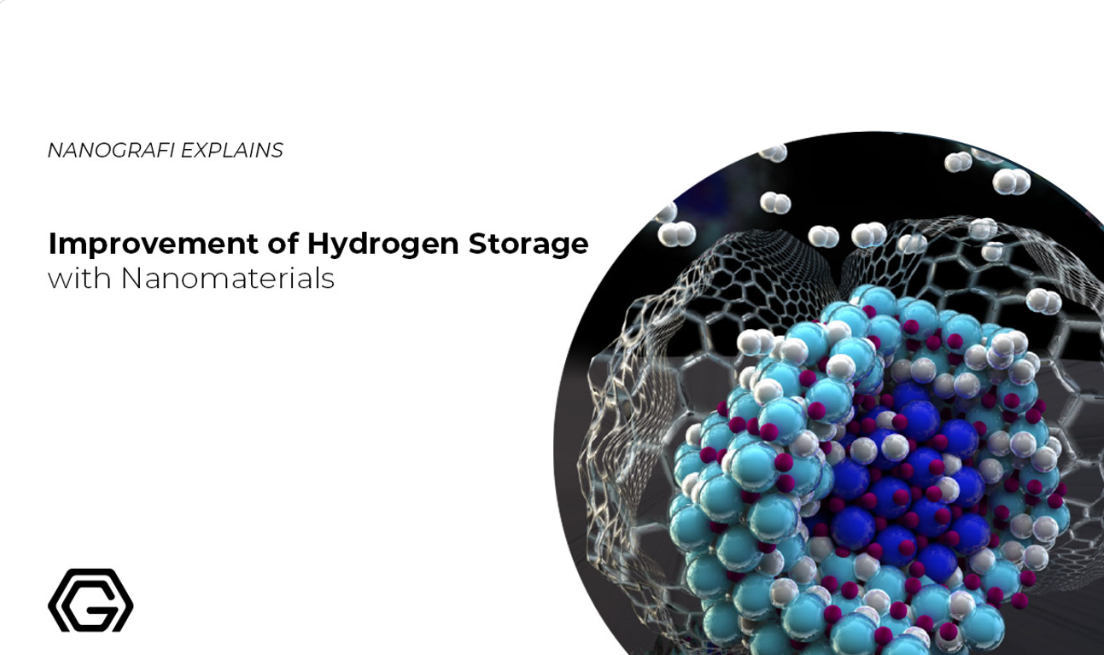
To learn more about hydrogen storage with nanomaterials, read our blog.
Chemical Hydride Storage
How Chemical Hydrides Work
Chemical hydrides are a class of compounds that can store and release hydrogen through chemical reactions. Unlike physical storage methods like compressed or liquefied hydrogen, chemical hydrides rely on chemical reactions to reversibly bind and release hydrogen. Here is an overview of how chemical hydrides work:
1. Hydrogen absorption
2. Chemical bonding
3. Hydrogen release
4. Energy input
5. Reversibility
6. Hydrogen storage capacity
Chemical hydrides offer several advantages, including high hydrogen storage capacities, the ability to store hydrogen at ambient temperatures and pressures, and the potential for controlled and on-demand hydrogen release. However, they also face challenges such as reaction kinetics, thermodynamics, and the need for suitable catalysts or conditions to facilitate hydrogen release. Research and development efforts focus on discovering new chemical hydrides, optimizing their properties, and exploring methods to enhance the efficiency and practicality of chemical hydride-based hydrogen storage systems.
Different Types of Chemical Hydrides
There are various types of chemical hydrides that can store and release hydrogen through chemical reactions. These types can be categorized based on the nature of the chemical bonding and the elements involved. Here are some common types of chemical hydrides:
1. Ionic hydrides
2. Covalent hydrides
3. Complex metal hydrides
4. Amides and imides
5. Borohydrides
6. Organic hydrides
Challanges and Advantages
These are just a few examples of the different types of chemical hydrides. Each type has its own characteristics, hydrogen storage capacity, and conditions for hydrogen release. Researchers continue to explore and develop new chemical hydrides with improved properties, such as enhanced hydrogen storage capacities, lower operating temperatures, and more efficient hydrogen release mechanisms.
Carbon-based Materials for Hydrogen Storage
Carbon-based materials have garnered significant attention as potential candidates for hydrogen storage due to their unique properties and versatility. Here are some examples of carbon-based materials used for hydrogen storage:
- Carbon nanotubes (CNTs)
- Graphene
- Carbon nanofibers (CNFs)
- Porous carbon materials
- Metal-organic frameworks (MOFs)
- Carbon-based hydrogen storage composites
Carbon-based materials for hydrogen storage offer advantages such as low cost, abundance, and tunable properties. However, challenges remain, including optimizing the hydrogen storage capacities, enhancing the kinetics of hydrogen uptake and release, and addressing the stability and reversibility of the hydrogen storage process.
Borophene: A Promising Carbon-based Material for Hydrogen Storage
Borophene is a two-dimensional (2D) allotrope of boron that exhibits a unique atomic structure and intriguing properties. Here is an overview of the structure and properties of borophene:
Structure
Atomic arrangement: Borophene consists of a single layer of boron atoms arranged in a hexagonal lattice. The boron atoms form triangular or hexagonal units, creating a honeycomb-like structure. The arrangement of boron atoms can vary, leading to different borophene structures with distinct properties.
Defects and patterns: Borophene can exhibit various defects, such as vacancies or substitutions, which can significantly influence its properties. Additionally, borophene can form different patterns, including stripe-like, porous, or holey structures, depending on the arrangement of boron atoms.
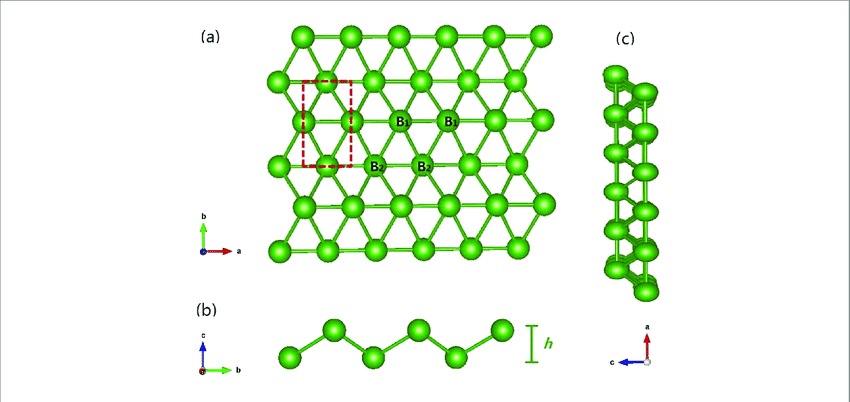
Figure 5. Atomic structure of borophene.
Properties:
Metallic nature: Borophene is typically considered a metallic material, meaning it conducts electricity well. The metallic behavior arises from the partially filled electronic bands in the borophene structure, which allow for the free movement of electrons.
Anisotropic properties: Borophene exhibits anisotropic properties, meaning its properties differ along different directions within the material.
Mechanical strength: Borophene is known for its exceptional mechanical strength. It can withstand large strains without breaking due to strong covalent bonding between boron atoms.
Thermal conductivity: Borophene exhibits high thermal conductivity, enabling efficient heat transfer.
Chemical reactivity: Borophene is chemically reactive and can interact with other substances.
Potential for hydrogen storage: Its 2D structure and the ability to adsorb hydrogen atoms on its surface make it a promising candidate for hydrogen storage applications.
It's important to note that borophene is a relatively new material, and research on its structure and properties is still ongoing. Scientists are exploring different synthesis methods and investigating the potential applications of borophene in various fields, including electronics, energy storage, catalysis, and more. The unique structure and properties of borophene make it an intriguing material for further exploration and potential technological advancements.
Carbon Nanotubes and Graphene (Graphene and CNT)
Carbon nanotubes (CNTs) and graphene are both carbon-based materials with unique structures and exceptional properties. Here's a comparison between graphene and carbon nanotubes:
Graphene
Structure: Graphene is a single layer of carbon atoms arranged in a hexagonal lattice. It forms a two-dimensional (2D) honeycomb structure.
Electrical conductivity: Graphene is an excellent conductor of electricity due to its unique electronic band structure. It allows for the free movement of electrons, making it highly conductive.
Mechanical strength: Graphene is incredibly strong and has a high tensile strength. It is one of the strongest materials known, with exceptional mechanical properties.
Optical properties: It is transparent and absorbs only a small fraction of light across a broad range of wavelengths, making it a promising material for optoelectronic applications.
Thermal conductivity: Graphene has exceptionally high thermal conductivity, allowing it to efficiently transfer heat. This property makes it desirable for thermal management applications.
Flexibility: Graphene is highly flexible and can be bent, folded, or stretched without breaking. This flexibility makes it suitable for flexible electronics and other applications that require bendable materials.
Explore the 60 application areas of graphene, the most widely read topic on our blog, by visiting our website.
Carbon Nanotubes (CNT)
Structure: CNTs are cylindrical structures composed of rolled-up graphene sheets. They can have different structures depending on the arrangement of the carbon atoms, including single-walled (SWCNTs) or multi-walled (MWCNTs) nanotubes.
Electrical conductivity: CNTs exhibit excellent electrical conductivity, similar to graphene. They can act as metallic or semiconducting materials, depending on their structure and diameter.
Mechanical strength: CNTs are exceptionally strong and have high tensile strength. They can withstand significant mechanical stresses and strains without breaking.
Aspect ratio: CNTs have a high aspect ratio, meaning their length is significantly greater than their diameter. This unique aspect ratio makes them useful in applications requiring reinforcement or as building blocks for nanoscale devices.
Applications: CNTs have found applications in various fields, including electronics, energy storage, composites, sensors, and nanomedicine, due to their exceptional properties and nanoscale dimensions.
While both graphene and CNTs share several properties, such as high electrical conductivity, mechanical strength, and thermal conductivity, they differ in their structures and applications. Graphene's 2D structure and exceptional electrical and optical properties have led to its use in electronics, photonics, and energy-related applications. On the other hand, CNTs' unique tubular structure and high aspect ratio make them suitable for reinforcement, nanoelectronics, and other nanoscale applications. Both materials continue to be extensively studied and hold great promise for future technological advancements.
Porous Materials and Metal-organic Frameworks (MOFs)
Porous materials, such as metal-organic frameworks (MOFs), are characterized by their ability to incorporate and store guest molecules within their porous structure. They offer high surface areas and tailored pore structures, making them suitable for various applications. MOFs, in particular, are composed of metal ions or clusters connected by organic ligands, forming a crystalline framework with regularly spaced pores. They possess tunable properties and have shown promise in gas storage and separation. However, challenges such as stability need to be addressed. Overall, porous materials, including MOFs, continue to be an active area of research with potential applications in energy, environment, and other fields.
Hydrogen Sorption Mechanisms
Hydrogen sorption mechanisms involve the adsorption or absorption of hydrogen gas onto a material for storage purposes. The main mechanisms include physisorption and chemisorption, as well as a combination of both.
Physisorption is the physical adsorption of hydrogen onto a material's surface, primarily through weak van der Waals forces. It is observed in materials with a large surface area, such as activated carbon, metal-organic frameworks (MOFs), and certain zeolites.
Chemisorption involves a chemical reaction between hydrogen and the storage material, forming chemical bonds. It typically requires higher temperatures and sometimes the presence of a catalyst. Chemisorption occurs through processes like dissociative chemisorption, where hydrogen molecules dissociate into individual atoms that bond with the material. Examples of materials that exhibit chemisorption include metal hydrides, complex metal alloys, and certain MOFs.
Some materials can exhibit a combination of physisorption and chemisorption mechanisms. Metal-organic frameworks, for instance, may have physical adsorption sites as well as metal centers for chemical bonding. This combination allows for enhanced storage capacities and improved kinetics.
The choice of hydrogen sorption mechanism depends on factors such as storage capacity, operating conditions, and specific application requirements. Ongoing research aims to develop new materials and mechanisms for improved hydrogen storage, benefiting applications like fuel cells and hydrogen-powered vehicles.
Future Trends and Challenges
Future trends and challenges in hydrogen sorption mechanisms and storage technologies revolve around developing advanced materials with higher storage capacities, improving thermodynamics and kinetics, establishing a robust hydrogen infrastructure, addressing safety considerations, reducing costs, integrating with renewable energy systems, establishing standards and regulations, and evaluating environmental impacts. Overcoming these challenges will be essential for the widespread adoption of hydrogen as a clean and efficient energy carrier.
Technological Advancements
Technological advancements in hydrogen sorption mechanisms and storage have led to the development of advanced materials, such as metal-organic frameworks and carbon nanomaterials, with higher storage capacities and improved kinetics. Nanotechnology and catalysts have played crucial roles in enhancing hydrogen adsorption properties and reaction rates. Complex hydrides and hybrid storage systems combining different mechanisms have been explored for optimized performance. Advanced characterization techniques and computational modeling have provided valuable insights for material design and system optimization. These advancements contribute to making hydrogen storage more efficient and practical for various applications.

Conclusion
Hydrogen storage methods include compressed gas, liquid hydrogen, metal hydrides, chemical hydrides, and carbon-based materials. Each method has its advantages and challenges, and the choice depends on factors such as storage capacity, safety, and cost. Ongoing research aims to develop advanced materials and systems for efficient hydrogen storage. Hydrogen has strong potential as a clean energy solution due to its versatility, ability to store renewable energy, decarbonization benefits, high energy density, diverse applications, technological advancements, and international support. Challenges remain, but hydrogen is poised to play a crucial role in the transition to a clean and sustainable energy system. We are dedicated to developing and producing products that align with our mission for a cleaner and more sustainable energy future.
Step into the future with Nanografi, visit our website to learn more.
References
60 Uses and Applications of Graphene – Nanografi - Nanografi Nano Technology. (n.d.). Retrieved March 14, 2024, from https://nanografi.com/blog/60-uses-and-applications-of-graphene-nanografi-/
Fuel Cells Development with Nanotechnology - Nanografi Nano Technology. (n.d.). Retrieved March 14, 2024, from https://nanografi.com/blog/fuel-cells-development-with-nanotechnology-728a03/
Hydrogen Storage | Department of Energy. (n.d.). Retrieved March 14, 2024, from https://www.energy.gov/eere/fuelcells/hydrogen-storage
Improvement of Hydrogen Storage with Nanomaterials - Nanografi Nano Technology. (n.d.). Retrieved March 14, 2024, from https://nanografi.com/blog/improvement-of-hydrogen-storage-with-nanomaterials-9752b8/
Physisorption - Wikipedia. (n.d.). Retrieved March 14, 2024, from https://en.wikipedia.org/wiki/Physisorption
Schematic picture of the FCC unit cell of the titanium hydrides TiH x... | Download Scientific Diagram. (n.d.). Retrieved March 14, 2024, from https://www.researchgate.net/figure/Schematic-picture-of-the-FCC-unit-cell-of-the-titanium-hydrides-TiH-x-1-x-2-phase_fig4_257975785
Shafiee, S., & McCay, M. H. (2016). Different reactor and heat exchanger configurations for metal hydride hydrogen storage systems - A review. International Journal of Hydrogen Energy, 41(22), 9462–9470. https://doi.org/10.1016/j.ijhydene.2016.03.133
Simplified schematic diagram of the hydrogen liquefaction process based... | Download Scientific Diagram. (n.d.). Retrieved March 14, 2024, from https://www.researchgate.net/figure/Simplified-schematic-diagram-of-the-hydrogen-liquefaction-process-based-on-simple-Claude_fig2_360078745
Unit cell of stoichiometric δ-ZrH 2 (space group 225) with Zr-atoms... | Download Scientific Diagram. (n.d.). Retrieved March 14, 2024, from https://www.researchgate.net/figure/Unit-cell-of-stoichiometric-d-ZrH-2-space-group-225-with-Zr-atoms-red-spheres-in_fig4_320766142
Recent Posts
-
Advanced Materials for Unmanned Aerial Vehicle (UAV) Protection Against Laser
Consider a UAV on a critical mission, rendered inoperative by a sudden laser attack. With the increa …26th Jul 2024 -
Simulation and Modeling of Material Properties
Our world is composed of a dazzling array of materials, each with its own unique properties that dic …19th Jul 2024 -
Advanced Coatings for Superior Corrosion and Wear Resistance
Corrosion and wear pose significant challenges across various industries, leading to substantial eco …12th Jul 2024

